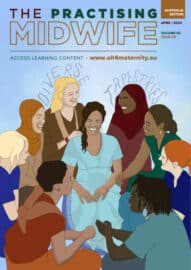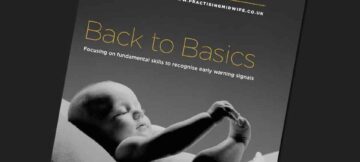Review of Care Quality Commission (CQC) Maternity Survey
Sam Todd – Lead for Professional Practice and A-EQUIP, Birmingham Women’s and Children’s NHS Foundation Trust
Social @samueltodd16

Introduction
The findings of the Care Quality Commission (CQC) Maternity Survey 2023 were published February 09, 2024.1 The purpose of the survey is to provide an insight into the experience of women and birthing people who had a live birth in the United Kingdom (UK). The findings of the survey should be used by those who work in and commission maternity services to improve both outcomes and experiences of care.
The survey, which is undertaken annually, involved the participation of 121 NHS maternity units – a response rate of 41%, with 25,515 voices contributing (an increase from the previous year where there was 20,927 respondents).2 Data was collected from women who birthed between February 01 and 28, 2023. If the NHS maternity unit did not have a minimum of 300 live births in February the survey was extended to births that occurred in January, with feedback being collected between April and August 2023.
The full report can be accessed here.
The findings of the most recent survey continue to highlight a deterioration in women’s experiences of care from maternity services
Survey findings
The findings of the most recent survey continue to highlight a deterioration in women’s experiences of care from maternity services (Table 1). It shows that 24% of women did not have the opportunity to ask questions about their labour and birth, 25% of women reported being left alone at some point during, or shortly after, the birth at a time when they were worried. Furthermore, 37% of women felt that following birth they did not have access to a midwife as much as they wanted.
| Table 1: Key areas for improvement | |
| 2023 findings | 2022 findings |
| From the 2023 survey two key areas were identified:
· Availability of staff. · Communications and interactions with staff. |
From the 2022 survey three key areas were identified:
· Availability of staff. · Confidence and trust. · Communications and interactions with staff. |
However, the survey highlighted some positive results which should provide confidence that change is occurring in maternity services to reduce the incidence of poor care experiences (Table 2). Statistically significant improvements were seen in all 13 evaluative questions related to antenatal care between 2022 and 2023. Women reported better experiences of antenatal and postnatal mental health support than in 2022 with 75% of women reporting that their midwife ‘definitely’ asked about their mental health during pregnancy. Furthermore 88% of women reported that they ‘definitely’ received support in 2023, compared to 85% in 2022.
| Table 2: Positive results | |
| 2023 findings | 2022 findings |
| From the 2023 survey two positive results were identified:
· Antenatal care. · Mental health support. |
From the 2022 survey two positive results were identified:
· An improvement in reported delays with hospital discharge. · Mental health support. |
In response to the CQC Maternity Survey 2022, which can be accessed here, the impact of culture and compassionate and inclusive leadership were explored as a solution to address some of the highlighted concerns.3 It is widely accepted that service user outcomes and experiences are improved when there is a ‘good’ workplace culture. However, it is apparent that many maternity units struggle to achieve this. A starting point to address culture in the workplace can begin by examining how inclusive the organisation is.
Compassionate leadership can offer a solution to improving workplace culture
Compassion and workplace culture
Integrity and leadership are a key tenet of midwifery practice,4 however, midwives might not have considered their own personal leadership styles or be aware of leadership styles to aspire to. Furthermore, much of the midwifery workforce do not think that they are working in a ‘leadership’ role which might impact midwives viewing themselves as leaders. This has the potential for midwives to become ‘passive’ rather than ‘active’. The difference being that when midwives are ‘passive’ they are waiting for things to happen and then reacting rather than being ‘active’ which has a more generative and responsive approach. Furthermore, when midwives experience a combination of poor leadership and an excessive workload it can be difficult for midwives to find joy in their work and may contribute to negative feelings regarding whether to stay in midwifery. Compassionate leadership can offer a solution to improving workplace culture, the wellbeing of staff and in turn improving patient outcomes and experiences.5 Compassion enables a more inclusive workplace culture which creates a psychologically and culturally safe environment.5
Maternity services continue to be affected by health disparities and inequalities by ethnicity. The most recent MBRRACE report highlights that Black women are four times more likely to die and Asian women are twice as likely to die than White women.6 Ethnicity should not be a factor in adverse healthcare outcomes, therefore we need to examine effective ways to address this. Organisations and healthcare professionals need to move from ‘not racist’ to ‘anti-racist’ to fight racism.7 The benefits of this would extend to improving workplace culture ensuring maternity units are inclusive as well as the urgent need to address health outcomes based on ethnicity.
CARE is a tool produced by the Nursing and Midwifery Council which stands for Compassion, Active listening, Response and Effectiveness.8 It would be beneficial for midwives and teams to utilise tools such as CARE to reflect on experiences of caring for women and birthing people (Table 3). The concern of not being heard is a recurrent theme from national reports and inquiries and appears to be a contributing factor in cases where there is an adverse outcome. By working towards a compassionate and inclusive leadership style and reflecting on interactions with women and birthing people using the CARE tool, midwives might address some/all the key areas for improvement within the CQC Maternity Survey. To support this, midwives need to feel valued, with time invested in improving their emotional wellbeing and resilience.
| Table 3: The CARE tool | |
| Compassion | How did you show compassion, meet her personal needs and build a partnership? |
| Active listening | How did you actively listen to her choices and questions, making her feel listened to and comfortable? |
| Response | What did you do as a result of what she told you? |
| Effectiveness | What was the positive impact of your care? What did you learn and would you do anything differently next time? |
Professional Midwifery Advocates (PMAs)
PMAs deploy the Advocating for Education and Quality Improvement (A-EQUIP) model which has four functions:
- Monitoring, Evaluation and Quality Control (normative)
- Clinical Supervision (restorative)
- Personal Action for Quality Improvement
- Education and Development (formative).9
PMAs offer the potential for addressing and meeting the wellbeing needs of midwives through Restorative Clinical Supervision (RCS). However, for this to be effective the number of midwives to PMAs considered to be appropriate should be no more than 20-1. Arguably there is currently not enough PMAs to effectively deploy RCS. Therefore, further investment is required to ensure that all maternity units have enough PMAs based on a ratio of 20-1 to fully realise the benefits of this element of the A-EQUIP model. Additionally, if there were sufficient numbers of PMAs the other elements of the A-EQUIP model would support improvements in maternity care (Table 4).
| Table 4: The four functions of A-EQUIP | |
| Function | The role of the PMA in relation to the function |
| Monitoring, Evaluation and Quality Control (normative) | PMAs could be utilised to support midwives to undertake an audit of their own record keeping using a tool such as this tool from the Royal College of Midwives.10 This would promote personal and professional accountability and support a high standard of care. The PMA would be able to facilitate a supportive discussion where the findings of the audit may validate the care the midwife provided or identify areas for improvement and any consequences that may have arisen from errors. |
| Clinical Supervision (restorative) | Anecdotally RCS is the most well-known element of the A-EQUIP model and is concerned with emotional wellbeing and resilience. By enabling staff regular access to RCS midwives would experience a reduction in stress and burnout whilst improving compassion and retention of staff. |
| Personal Action for Quality Improvement | PMAs can support the midwifery workforce to embed learning from local and national incidents into practice. Furthermore, PMAs can support midwives to contribute to service improvements made as a result of user feedback and staff feedback. |
| Education and Development (formative) | Learning from national reports, inquiries and the CQC maternity survey could be addressed by PMAs with the development of knowledge and skills through education. This process would be enhanced if PMAs undertook annual appraisals, revalidation and leadership development. However, for this to be effective there needs to be an appropriate ratio of midwives to PMAs. |
Blame, love and empathy
Communication continues to be an area of concern with maternity services. The above offers some insight into a few areas that could be improved to address ongoing concerns about maternity services. However, ultimately how we communicate with women and birthing people needs to be urgently addressed. We need to explore the concepts of blame, love and empathy and understand how they apply to maternity services and the interactions that we have. The following links contain videos that will explain these concepts in greater detail and may offer you the opportunity to reflect on experiences of care that you have provided to women and birthing people.
Midwives and obstetricians must prioritise communicating with women and birthing people
Brené Brown on blame: ‘Blaming is very corrosive in relationships and its one of the reasons we miss our opportunities for empathy’.11
Sheena Byrom on love: ‘Loving what we do, loving the women we care for, and loving each other’.12
Brené Brown on empathy: ‘Because the truth is, rarely can a response make something better. What makes something better is connection’.13
Midwives, with their teams, should review the findings of the survey to seek out how their maternity service was reported, to celebrate the positive findings and identify ways to address suboptimal areas. Midwives and obstetricians must prioritise communicating with women and birthing people. It is important to remember that short-term acts of kindness and compassion might have long-term benefits for both women and staff.
References
- Maternity survey 2023. Care Quality Commission. https://www.cqc.org.uk/publications/surveys/maternity-survey. Published February 09, 2024. Accessed March 12, 2024.
- National survey shows decline in positive maternity experiences. Care Quality Commission. https://www.cqc.org.uk/press-release/national-survey-shows-decline-positive-maternity-experiences. Published January 11, 2023. Accessed March 12, 2024.
- Todd, S. Care Quality Commission 2022 Maternity Survey. TPM. https://www.all4maternity.com/care-quality-commission-2022-maternity-survey/. Published February 20, 2023. Accessed March 19, 2024.
- The Code: Professional standards of practice and behaviour for nurses, midwives and nursing associates. NMC. https://www.nmc.org.uk/globalassets/sitedocuments/nmc-publications/nmc-code.pdf. Updated October 10, 2018. Accessed March 19, 2024.
- Bailey, S. West, M. What is compassionate leadership? The King’s Fund. https://www.kingsfund.org.uk/insight-and-analysis/long-reads/what-is-compassionate-leadership. Published February 15, 2022. Accessed, April 04, 2024.
- Knight M, Bunch K, Felker A, Patel R, Kotnis R, Kenyon S, Kurinczuk JJ (Eds.) on behalf of MBRRACE-UK. Saving Lives, Improving Mothers’ Care Core Report – Lessons learned to inform maternity care from the UK and Ireland Confidential Enquiries into Maternal Deaths and Morbidity 2019-21. Oxford: National Perinatal Epidemiology Unit, University of Oxford 2023.
- Newitt S, Warmington, J. Moving from not racist to anti-racist. The King’s Fund. https://www.kingsfund.org.uk/insight-and-analysis/blogs/moving-from-not-racist-to-anti-racist. Published March 18, 2024. Accessed April 04, 2024.
- The best care happens in partnership. NMC. https://www.nmc.org.uk/globalassets/images/campaigns/partnerships/nmc-reflective-aid_v10a.pdf. Accessed April 04, 2024.
- A-EQUIP a model of midwifery supervision. NHS England. https://www.england.nhs.uk/wp-content/uploads/2017/04/a-equip-midwifery-supervision-model.pdf. Published April 07, 2017. Accessed April 04, 2024.
- Electronic Record Keeping Guidance and Audit Tool. RCM. https://www.rcm.org.uk/media/4818/rcm_guidance-report_elec_record_keeping.pdf. Accessed April 04, 2024.
- Brown B. Brené Brown on Blame. https://www.youtube.com/watch?v=RZWf2_2L2v8. Published February 03, 2015. Accessed April 04, 2024.
- Byrom S. The real work life balance kindness, caring and compassion. https://www.youtube.com/watch?v=BDNPUr81YrA. Published December 17, 2018. Accessed April 04, 2024.
- Brown B. Brené Brown on Empathy. https://www.youtube.com/watch?v=1Evwgu369Jw. Published December 10, 2013. Accessed April 04, 2024.










